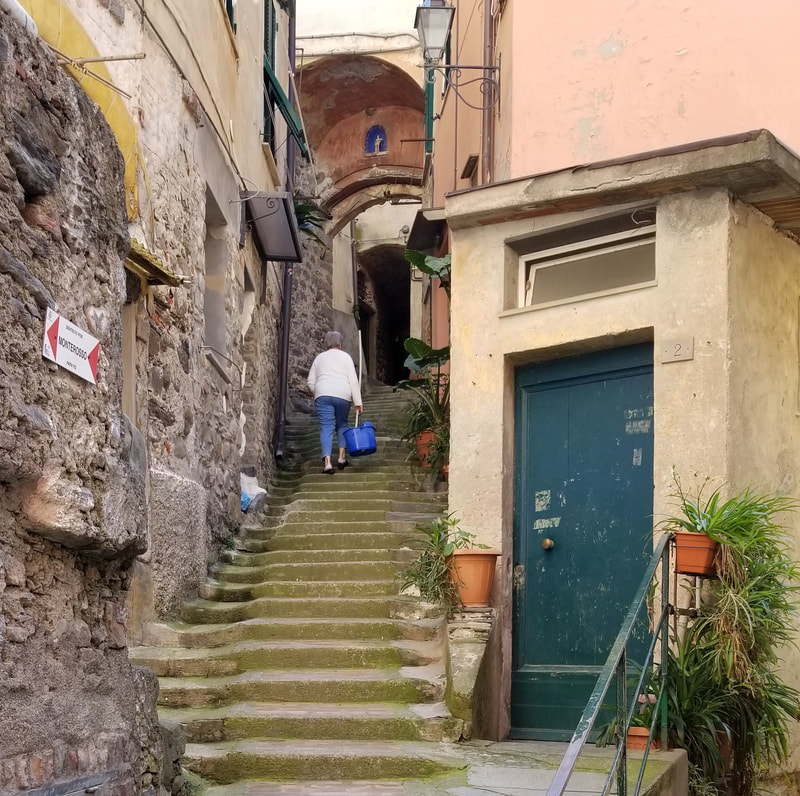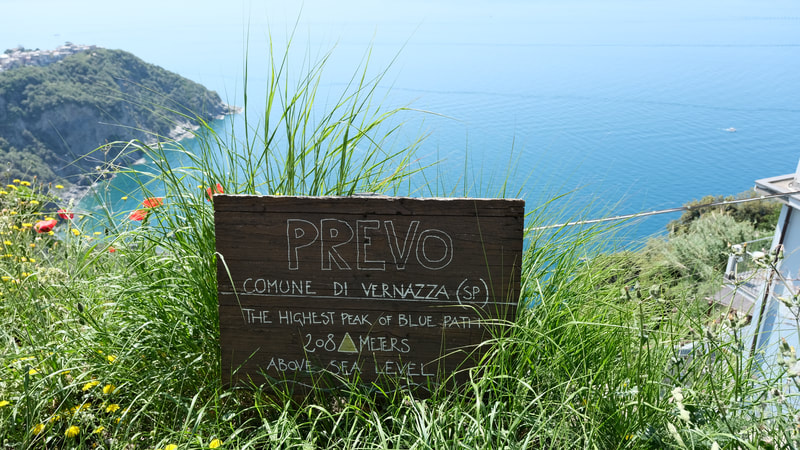|
written and photographed by Marcia Simon, copyright 2023 Getting to Cinque Terre in Northwestern Italy is usually by train from Florence, Genoa or Milan. Once you get there, the best way to see not just the five main villages, but the stunningly beautiful vistas from a totally different perspective, is by walking. A hiking tour of the area generally takes you through the eight-mile trail in Cinque Terre National Park. It doesn't sound like a long hike, but with the villages at sea level and the trails perched above the colorful coastline, the ascending and descending paths, plus numerous stops for photos, lunch, gelato and shopping in the villages, this is best enjoyed as a multi-day experience. Hiking gives you an immersive experience that day trippers from cruise ships and tour buses simply don't get. While village restaurants serve up scrumptious meals with local seafood, lemons, olives and Cinque Terre wines, our hiking tour allowed us to walk through the farms, and taste in the vineyards. Cinque Terre is in the region known as Liguria or the Italian Riviera. This Mediterranean coastline straddles the south of France and Tuscany. The eastern coast of the Ligurian Sea includes Cinque Terre's rugged cliffs, turquoise coves and pastel-colored seaside villages. The "Five Lands" It's easy to shuttle between Monterosso, Vernazza, Corniglia, Manarola and Riomaggiore using the Cinque Terre Train Pass. A prepay ticket gives you unlimited transport between all five of these villages.  The day winds down in Monterosso. The day winds down in Monterosso. Monterosso, the largest and northernmost of the Cinque Terre, serves as a good home base. It's the only village with an actual public beach, which is lined with ample waterfront bars and gelato stands. Taking the train from Milan got us in to Monterosso mid-afternoon, so we had time to relax before beginning our official hiking itinerary, arranged with the help of Girosole Italy Walking Tours. Upon arrival we settled in at the Hotel Margherita, where the train station, beach, shops restaurants and hiking trail are all within easy walking distance. We quickly ventured into town for our first Aperol Spritz of the week. Cocktails and aperitivos are generally served with complimentary local olives and other salty snack to offset some alcohol and keep the thirst craving intact. Our hike began along the coast heading south. About three miles later we saw the small harbor of Vernazza, perhaps the most photographed of all the villages. As we continued the walk, the village kept getting closer, and the vista kept changing until we reached the village center. It was an adrenaline rush. Wanting more, we continued on to Corniglia. The Ligurian coastline is vulnerable to the effects of climate change. In recent years, dry periods followed by heavy rain have caused mudslides and temporary trail closures in Cinque Terre National Park while repair work is done. Such was the case on one stretch of trail during our trip between the two southernmost towns Manarola and Riomaggiore. An alternate, longer trail veers away from the coast and up a large hill. Instead, we wanted to see the ocean, so we hopped the train back to Monterosso for our end-of-day Aperol Spritz.  Riomaggiore – the southernmost village of Cinque Terre Riomaggiore – the southernmost village of Cinque Terre The next day started with a short train ride to Riomaggiore where we were fortunate to see the morning sun illuminating the multicolored hues of the buildings, fishing boats and kayaks in the marina. Standing in the middle of an iconic Cinque Terre photo scene, we did our best to capture our own images. After taking an excessive amount of photos and a leisurely stroll, we took the short train ride (literally 2 minutes) to Manarola and continued our walking journey. This was a highlight of the trip as, along the way while passing through the village border of Volastra, we encountered the Capellini Winery. It's right on the trail, overlooking terraced vineyards. (A few B&Bs are tucked into the countryside here for hikers who want to enjoy a sunset and dinner at Cantina Capellini without having to hike back to town afterward. The sea view was literally awesome as we gradually made our way down to the village of Corniglia and then the 377 steps to the train station. The trail is well marked and protected with rustic railings so it is never scary.  Aromatic fresh fruit in a street market Aromatic fresh fruit in a street market The Foods of Cinque Terre Brochures describe Cinque Terre as five fishing villages, but some of the locals say the history goes back to farming and creating terraces of level ground for crops and cattle even before the fishermen established their industry. Breakfast is generally always included with a hotel stay, and most often starts with coffee – espresso, cappuccino or Americano. You can expect breads, some type of meat protein, cheeses and a choice of yogurt, fruits and assorted pastries. Anchovies are the local fish, often eaten on salads or pizza, but not salted or cured. Because they are fresh, the flavor is more delicate, especially when lightly fried on a platter shared with local mussels and calamari. Liguria is the home of pesto. Apparently, pesto was "invented" in a small village outside of Genoa when the monks of a monastery dedicated to St. Basil gathered the aromatic ground cover growing on the hills. This "basil' was pounded by mortar and pestle with other local ingredients including pine nuts from trees that dotted the countryside, cheese from nearby dairy cows and olive oil. Today, Pesto Genovese is a popular pasta dish, particularly using trofie, which is a local twisted pasta cut into little rods. Focaccia and bruschetta are popular as street food or small plates, often with pesto and tomatoes, olive tapenade, little shrimp or freshly caught anchovies. We sampled the local flavors at Beach Bar Stella Marina on Monterosso's waterfront. Dinner includes local breads and antipasto of local hams and cheese, and of course there's no shortage of pizza or gelato. When to Go May has become an incredibly popular month for tourism in Italy. No longer will you beat the crowds if you head over mid-May. If you go in the summer, hiking trails may be overcrowded, and the sun can become intense. We went the first week of May, and it was perfect. Admittedly, luck played a part of that because after we left, the area was hit with three days of heavy rain. But - it's the rain that keeps the lush green mountains producing the crops and creating the jaw-dropping scenery. Sustainability As countries and regions across the globe find ways to address climate change, the challenges seem most real in ancient areas where infrastructure may be delicate or protected - and preserving history is a zoning priority over solar panels and other visible technological upgrades. Hotels, for the most part, seem to have adopted the practice of less frequent laundry service. Single-use plastic seems to have vanished. You may not get a straw unless you ask for it, and it will be a paper straw. If you order take-away from a restaurant, you will not get plastic utensils and you will not get Styrofoam. Paper and wood have replaced plastic throughout the area – at least from what I saw. Cinque Terre Hiking – 10 Tips for Planning Your Trip
The Cinque Terre Train Pass allows you to easily find a home base and begin each day in a different spot. With this in mind, here are some tips to help enjoy daily walks in the Cinque Terre:
Marcia Simon is a Connecticut-based travel writer and owner of Friendly Group Travel. Connect via Facebook or Instagram @friendlygrouptravel or send email to [email protected]. Share
0 Comments
Your comment will be posted after it is approved.
Leave a Reply. |
AuthorMarcia Simon, CTA, APR, has been exploring new places since she was 17 years old and traveled around Europe on a Eurailpass with her best friend. Decades later, she still considers travel the best investment of time and money she's ever made for herself and her family. Categories
All
|
|
SIGN UP NOW FOR OUR NEWSLETTER WITH TRAVEL TIPS, IDEAS AND SPECIAL OFFERS
|









 RSS Feed
RSS Feed





